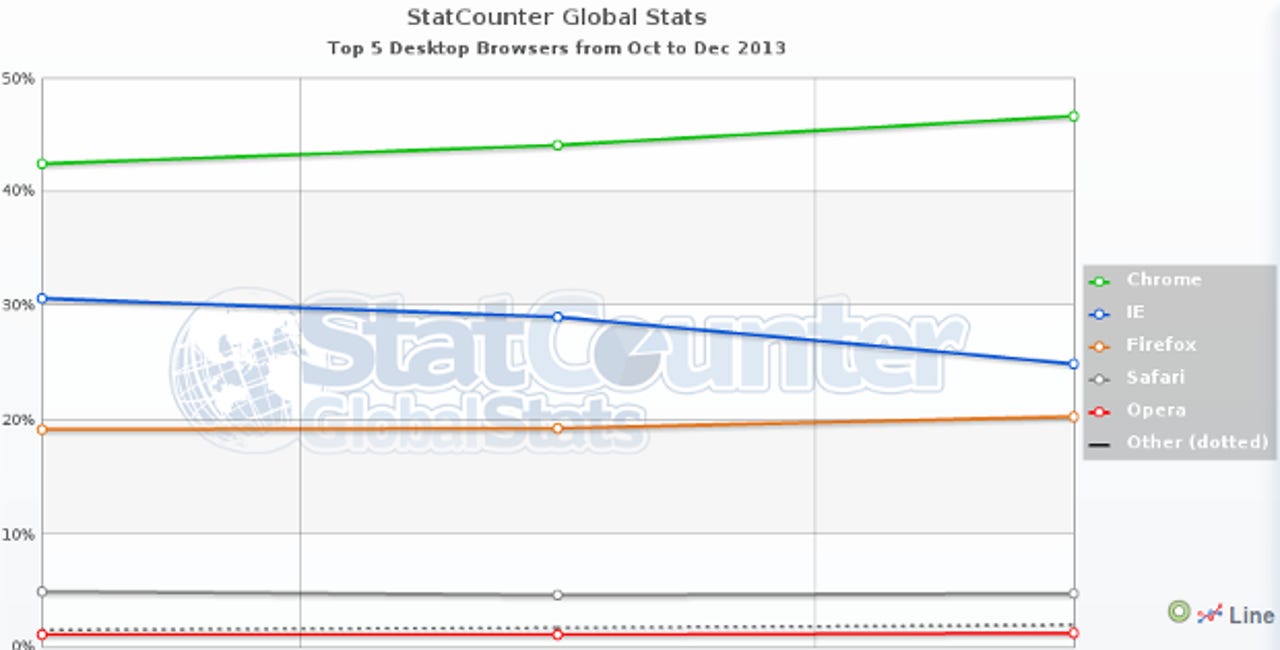Year-end Web browser dogfight results

My dog, Twiggy, a 15-pound Shih Tzu, is sure he's the neighborhood alpha dog despite the presence of much larger German Shepherds, Chows, and Labrador Retrievers, Because he has a "big dog" attitude, he gets away with it more often than not. When it comes to desktop Web browsers, however, the bigger the "dog," the more likely it is to be the top dog.
So, if you believe with StatCounter's Web browsers numbers for December 2013, Google Chrome is the browser big dog. On the other hand, if you buy into NetMarketShare's statistics, Internet Explorer (IE) is the dominant pooch.

StatCounter has had Chrome as number one since August 2012. In December 2013, StatCounter shows Chrome on top with 46.63 percent of global desktop users. IE comes in second with 24.91 percent and Firefox third with 20.3 percent. In the back of the pack we find Safari with 4.8 percent and Opera with 1.33 percent.
Looking at the last quarter, StatCounter finds Chrome growing quickly at IE's expense. In October Chrome had 42.45 percent and IE had 30.67 percent. That's a gain of 4.18 percent for Chrome and a loss of 5.76 percent for IE.
It's an entirely different world when you look through it with NetMarketShare-colored glasses. By NetMarketShare's count, IE's number one with 57.91 percent, a modest drop from the previous two months. Firefox is number two, with 18.45 percent with another small decline during the quarter, and Chrome, in the third spot, gained on the other two with 16.22 percent, an increase of 0.8 percent since October. The runts of the litter are Safari with a steady 5.83 percent and Opera with1.33 percent, and shrinking.
Say hello to the early days of Web browsers (gallery)
The two major Web browser tracking companies give us such different results because they use two different methodologies. While the results are all about Web browsers, the pair isn't really looking for the same thing. Net Applications, Net Market Share's parent company, is more interested in counting unique visitors' Web browser hits, while StatCounter looks at raw browser hits. For more on how each counts Web browsers see my article: The Web browser wars continue, and #1 is… well, that depends on whom you ask.
Featured
Which Web browser is the most popular also depends to some extent on the Websites their users prefer. For example, when I looked at ZDNet's own Web browser data for August 2013, I found 29.8 percent of ZDNet readers used Chrome. IE took second place with 19.9 percent and Firefox was in third place with 13.2 percent. Lagging in the back was Safari with 4.7 percent and Opera with 0.5 percent. 27.7 percent of browsers couldn't be identified.
I wasn't surprised since ZDNet readers tend to be early adopters and Chrome, for now at least, tends to be the most innovative of the Web browsers. You can also see this by the way ZDNet users flocked to the then relatively new IE 10.
And, what does all this have to do with big and little dogs? I'll tell you what. Once upon a time, a small company or group, like an Opera or Mozilla, could spring out of the pack and take over. Those days are done, these days the big dogs rule and that means Google and Microsoft are the real rivals to be the leader of the Web pack.
Related Stories: